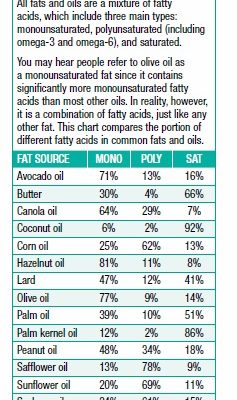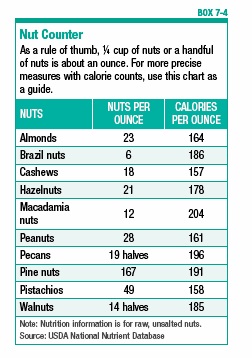7. Fats
Rethinking Fat Phobia
A mounting body of evidence shows that it’s more important to choose healthier fats than to avoid fat in our eating plans. In keeping with this, the 2015–2020 Dietary Guidelines for Americans say that a healthy eating pattern includes oils but limits fats associated with increased health risks, namely, trans fat and saturated fat. It’s also important to note that people tend to replace foods high in fat with foods high in refined carbohydrates (such as sugar and white flour) found in many highly processed, packaged foods. This practice can backfire on attempts to control your weight and reduce heart disease risk.
Fats (also called “fatty acids”) have many essential functions in the body. Fatty acids are required to form cell membranes and are converted to chemical regulators in the body that affect inflammation, blood clotting, blood vessel dilation, and more. Fats in the diet help the body absorb fat-soluble nutrients, such as vitamins A, D, E, and K, as well as disease-fighting phytochemicals like carotenoids and flavonoids.
Putting Fats Into Perspective
Although no one expects you to add up your daily fat grams or calculate what percent of your calories are coming from fat, some people find it helpful to have a frame of reference. The 2015–2020 Dietary Guidelines for Americans advise that a healthy total fat intake can range from 20–35 percent of daily calories. For someone consuming 2,000 calories a day, that’s 44 to 78 grams of total fat. Currently, about 34 percent of calories in Americans’ diets are estimated to come from fat. Keep in mind that this includes fats and oils you add to foods as well as the fat already present in foods.
In May 2016, the FDA announced changes to the Nutrition Facts label, including an increase in the Daily Value (DV) for total fat, which also aligns with the Dietary Guidelines. Historically, the DV for fat has been 65 grams, or 30 percent of calories, based on a 2,000-calorie diet. As nutrition labels are revised to comply with the new FDA rules by July 2018, manufacturers will be using a daily fat limit of 78 grams, or 35 percent of calories, to calculate a food’s percent DV for total fat. The bottom line: Limits on total fat intake are softening, with the emphasis shifting to a focus on choosing healthier fats.
The healthy fats we’re encouraged to consume include oils extracted from plants, such as olive, canola, and sunflower oils, as well as oils naturally present in nuts, seeds, seafood, olives, and avocados. These foods are rich in monounsaturated and polyunsaturated fats, which are more healthful and are preferred over foods high in saturated fat and/or containing man-made trans fat (see Box 7-1, “What’s Inside Fats and Oils?” on page 47).
Saturated Fat Guidelines
Saturated fat is naturally present in higher amounts in meat and full-fat dairy products, as well as tropical oils, such as coconut and palm oils. According to the 2015–2020 Dietary Guidelines for Americans, we should consume less than 10 percent of our daily calories from saturated fat (that’s about 20 grams for someone eating 2,000 calories a day). At the same time, U.S. nutrition experts are placing less emphasis on restricting intake of dietary cholesterol, noting that when people reduce their intake of animal products high in saturated fat, they automatically consume less cholesterol, too.
Some people, such as those with heart disease, type 2 diabetes, a family history of high cholesterol, and others who are at risk for cardiovascular disease, may benefit from further reductions in saturated fat intake. Guidelines from the American Heart Association and the American College of Cardiology advise people with elevated LDL (“bad”) cholesterol levels to restrict their saturated fat intake to five or six percent of daily calories, or about 11–13 grams of saturated fat for someone eating 2,000 calories a day.
Limiting Saturated Fat
The biggest source of saturated fat in U.S. diets is mixed dishes, especially dishes made with cheese, meat, or both. That includes foods like burgers, sandwiches, and tacos; pizza; rice, pasta, and grain dishes; and meat, poultry, and seafood dishes. Other major sources of saturated fat include snacks and sweets. Choosing leaner meats in small portions, selecting lower-fat dairy products, and checking the saturated fat in packaged foods and restaurant foods will help you keep your saturated fat intake low.
You may have heard that some foods that contain saturated fat may be beneficial to your health; this is because there are different types of saturated fatty acids. Some saturated fatty acids are still viewed as harmful, while others appear to be neutral or possibly positive in their effects. For example, some unique saturated fats in dairy products (called odd-chain saturated fatty acids) have been linked with a reduced risk of type 2 diabetes. And stearic acid, a saturated fat in meats and chocolate, may be healthier than other saturated fats because the body can convert it to a healthy monounsaturated fat called oleic acid. However, other saturated fatty acids in dairy and meat (such as myristic acid and palmitic acid) have been linked to cardiovascular disease.
Minimizing Trans Fat
The FDA deems man-made trans fat to be more harmful to cardiovascular health than any other fat, including saturated fat. Artificial trans fats have been shown to raise triglycerides, raise LDL cholesterol, lower HDL cholesterol, and promote inflammation, as well as worsen insulin resistance. Because trans fats have so many negative effects, in June 2015, the FDA issued a rule that trans fat can no longer be added to processed foods unless the manufacturer gets a waiver from the FDA to allow its use in a specific product. Manufacturers have until June 2018 to comply with this new rule.
While trans fats are being phased out, you still should check for them in packaged foods. Per labeling rules, if a food contains less than 0.5 grams of trans fat per serving, the amount of trans fat can be rounded down to 0 on the Nutrition Facts label. This means you have to check the ingredient list; if “partially hydrogenated oil” appears, the product contains trans fat. Even small amounts of trans fat are harmful to health and should be avoided when possible (see Box 7-2, “Reducing Trans and Saturated Fats,” on page 48 for ways to cut back on unhealthful fats).
Fitting in Healthy Fats
- Enjoy nuts.
Nuts are rich in healthy monounsaturated and polyunsaturated fatty acids, in addition to providing vitamin E, antioxidants, and other phytochemicals. Studies suggest eating one ounce (about ¼ cup) of nuts daily might help improve mood, control hunger, boost longevity, reduce diabetes risk, and help fight heart disease and stroke (see Box 7-3, “Daily Serving of Nuts Improves Cholesterol Levels”). However, like all foods rich in fats, nuts are high in calories (see Box 7-4, “Nut Counter”), so limit the total amount you consume, and replace other foods with nuts rather than merely adding them to your diet. For example, instead of chips, snack on nuts, and top your salad with chopped nuts, rather than croutons.
- Use oils instead of solid fats.
Using any vegetable oil is generally an improvement over highly processed solid fats, such as margarine and shortening. Additionally, the less refined the oil, the more phytochemicals, such as polyphenols, it typically contains. Extra-virgin olive oil (EVOO) contains far more polyphenols than regular or light olive oils, which undergo extensive refining (as do standard vegetable oils). In fact, EVOO averages 150 to 350 milligrams of polyphenols per kilogram (mg/kg) of oil, whereas refined olive oil’s polyphenol level averages just 2.7 mg/kg of oil. Polyphenols may be one of the protective components of EVOO that may reduce cardiovascular disease risk.
One caution: All oils (and fats), including EVOO, are calorie dense (see Box 7-5, “The Calories in Fats”). Always measure oils rather than “eyeballing” it, so you know how much you’re really using.
- Understand omega-6 fats.
Some plant-based oils are high in omega-6 polyunsaturated fats (see Box 7-1, “What’s Inside Fats and Oils?” on page 47). You may have heard that you should avoid omega-6 fats because they increase disease-producing inflammation. However, controlled studies in which people were fed oil rich in omega-6 fats failed to show an increase in markers of inflammation. The American Heart Association and leading cardiovascular experts still recommend replacing saturated fat in the diet with polyunsaturated fat (as well as monounsaturated fat), including both omega-6 and omega-3 polyunsaturated fatty acids.
- Enjoy avocados in moderation.
The fats in avocados are similar to those in olives, with the majority being healthy monounsaturated fat. Research has linked the healthy fats in avocados with improved LDL cholesterol.
- Eat fatty fish.
Wild-caught salmon is one of the best omega-3 sources. See pages 45-46 for information about fish, and Box 6-6 on page 46 for a list of fish that are rich in omega-3 fatty acids, which may not only benefit heart health but also protect cognitive function and promote longevity.
The post 7. Fats appeared first on University Health News.
Read Original Article: 7. Fats »
Powered by WPeMatico







